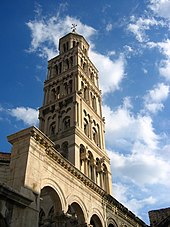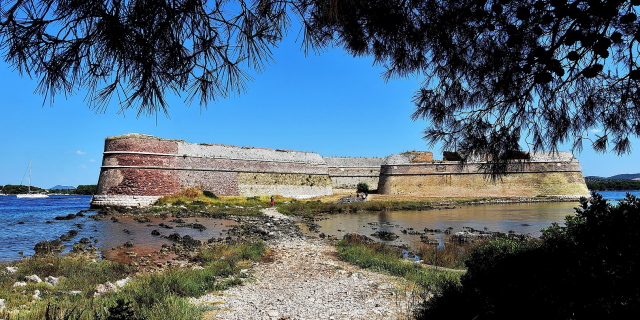Diocletian's Palace (Croatian: Dioklecijanova palača, pronounced [diɔklɛt͡sijǎːnɔʋa pǎlat͡ʃa]) is an ancient palace built for the Roman emperor Diocletian at the end of the third century AD, which today forms about half of the old town of Split, Croatia. While it is referred to as a "palace" because of its intended use as the retirement residence of Diocletian, the term can be misleading as the structure is massive and more resembles a large fortress: about half of it was for Diocletian's personal use, and the rest housed the military garrison.
The complex was built on a peninsula six kilometres (3.7 mi) southwest from Salona, the former capital of Dalmatia, one of the largest cities of the late empire with 60,000 people and the birthplace of Diocletian. The terrain around Salona slopes gently seaward and is typical karst, consisting of low limestone ridges runni...Read more
Diocletian's Palace (Croatian: Dioklecijanova palača, pronounced [diɔklɛt͡sijǎːnɔʋa pǎlat͡ʃa]) is an ancient palace built for the Roman emperor Diocletian at the end of the third century AD, which today forms about half of the old town of Split, Croatia. While it is referred to as a "palace" because of its intended use as the retirement residence of Diocletian, the term can be misleading as the structure is massive and more resembles a large fortress: about half of it was for Diocletian's personal use, and the rest housed the military garrison.
The complex was built on a peninsula six kilometres (3.7 mi) southwest from Salona, the former capital of Dalmatia, one of the largest cities of the late empire with 60,000 people and the birthplace of Diocletian. The terrain around Salona slopes gently seaward and is typical karst, consisting of low limestone ridges running east to west with marl in the clefts between them. Today the remains of the palace are part of the historic core of Split, which in 1979 was listed by UNESCO as a World Heritage Site.
Diocletian had ordered the construction of the heavily fortified compound near his hometown of Spalatum in preparation for his retirement on 1 May 305 AD.[1] The site chosen was near Salona, the provincial administrative centre of Dalmatia, on the southern side of a short peninsula. Based on Roman map data (known through the medieval parchment copy of the Tabula Peutingeriana), there was already a Spalatum settlement in that bay, the remains and size of which have not yet been established.
 Reconstruction of Diocletian's Palace in its original appearance upon completion in AD 305 (viewed from the south-west)
Reconstruction of Diocletian's Palace in its original appearance upon completion in AD 305 (viewed from the south-west)The beginning of construction of Diocletian's palace has not exactly been established. It is assumed to have begun around 295, after the introduction of the Tetrarchy (the rule of four). Yet ten years after that decision, when Diocletian abdicated in 305, the palace seems to have still been unfinished, and there are indications that some works were taking place while the emperor was residing at the Palace. It is unknown under whose architectural ideas the palace was built and who its builders were. The complex was modelled on Roman forts of the 3rd-century era, examples of which can be seen across the limes, such as the bridgehead fort of Castrum Divitia across the Rhine from Cologne.[2]
However, the engraved Greek names Zotikos and Filotas, as well as many Greek characters, indicate that a number of builders were originally from the eastern part of the empire, i.e. Diocletian brought with him masters from the East. Still, a large part of the workforce was likely of local origin. The basic materials came from close proximity. The white limestone comes from Brač and some of Seget near Trogir; tufa was extracted from nearby riverbeds, and bricks were made in Spalatum and other workshops located nearby.
At Carnuntum, people begged Diocletian to return to the throne in order to resolve the conflicts that had arisen through Constantine's rise to power and Maxentius' usurpation.[3] Diocletian famously replied:
If you could show the cabbage that I planted with my own hands to your emperor, he definitely wouldn't dare suggest that I replace the peace and happiness of this place with the storms of a never-satisfied greed.[4]
This was a reference to the Emperor retiring to his palace to grow cabbages.
Diocletian lived on for four more years, spending his days in his palace gardens. He saw his tetrarchic system fail, torn by the selfish ambitions of his successors. He heard of Maximian's third claim to the throne, his forced suicide, and his damnatio memoriae. In his palace, statues and portraits of his former companion emperor were torn down and destroyed. Deep in despair and illness, Diocletian may have committed suicide. He died on 3 December 312.[5][6][Note 1]
With the death of Diocletian, the life of the palace did not end, and it remained an imperial possession of the Roman court, providing shelter to the expelled members of the Emperor's family. In 480, Emperor Julius Nepos was murdered by one of his own soldiers, reportedly stabbed to death in his villa near Salona.[7] Since Diocletian's palace was in the area, it might have been the same building.
 The Romanesque bell tower of the Cathedral of Saint Domnius
The Romanesque bell tower of the Cathedral of Saint DomniusIts second life came when Salona was largely destroyed in the invasions of the Avars and Slavs in the 7th century, though the exact year of the destruction still remains an open debate between archaeologists. Part of the expelled population, now refugees, found shelter inside the palace's strong walls and with them a new, organized city life began.[8] Since then, the palace has been continuously occupied, with residents making their homes and businesses within the palace basement and directly in its walls.[9] St Martin's Church is an example of this trend. Today many restaurants and shops, and some homes can still be found within the walls.
In the period of the free medieval commune, between the 12th and 14th centuries, there was a greater architectural development when many medieval houses filled not only Roman buildings but also a large part of the free space of streets and docks. Also completed in this period was the construction of the Romanesque bell tower of the Cathedral of Saint Domnius, which inhabits the building that was originally erected as Jupiter's temple and then used as the Mausoleum of Diocletian.[10]
After the Middle Ages, the palace was virtually unknown in the rest of Europe until the Scottish architect Robert Adam had the ruins surveyed. Then, with the aid of French artist and antiquary Charles-Louis Clérisseau and several draughtsmen, Adam published Ruins of the Palace of Emperor Diocletian at Spalatro in Dalmatia (London, 1764).[11]
Diocletian's palace was an inspiration for Adam's new style of Neoclassical architecture[12] and the publication of measured drawings brought it into the design vocabulary of European architecture for the first time. A few decades later, in 1782, the French painter Louis-François Cassas created drawings of the palace, published by Joseph Lavallée in 1802 in the chronicles of his voyages.[13]
Today, the Palace is well preserved with all the most important historical buildings, in the centre of the city of Split, the second-largest city of modern Croatia. Diocletian's Palace far transcends local importance because of its degree of preservation. The Palace is one of the most famous and complete architectural and cultural features on the Croatian Adriatic coast. As the world's most complete remains of a Roman palace, it holds an outstanding place in Mediterranean, European, and world heritage.
Cite error: There are <ref group=Note> tags on this page, but the references will not show without a {{reflist|group=Note}} template (see the help page).































Add new comment